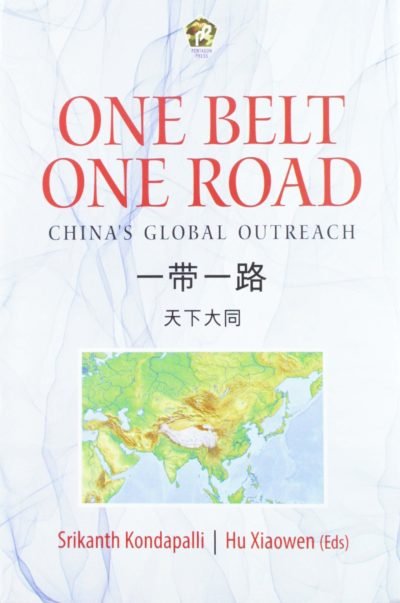Srikanth Kondapalli & Hu Xiaowen (Eds.) (2017), One Belt One Road: China's Global Outreach, New Delhi: Pentagon Press.
Pintu Kumar Mahla
 “The ‘Belt and Road’ initiative will not be a sole for China but a real chorus comprising all countries along the routes” - Xi Jinping.
“The ‘Belt and Road’ initiative will not be a sole for China but a real chorus comprising all countries along the routes” - Xi Jinping.
China's One Belt One Road initiative is making ripples, supported by three decades of economic reform, domestic upheaval, and a political rhetoric focused on swaying the outside world, all while being silently supported by the world's third largest armed forces. China is demonstrating great energy in diplomatic orientations with its neighbours and beyond, intending to unveil economic, technical, and managerial skills focused at connectedness across large sections of territory in Europe, Asia, Africa, and South America, and has recently made coordinated and inclusive preparedness at home and abroad.
The book is divided into two sections, with the first focusing on the OBOR's major ideas, initiatives, programmes, and constituents, as well as domestic political discussions and engagement, ancient cultural and economic underpinnings, political economy facets, integration initiatives across continents, maritime dimension, sustainability concerns, media understandings, and other topics. The second portion covers a number of countries' reactions and impressions of the Belt and Road initiative. The Editors of this book are Srikanth kondapalli and HU Xiaowen. Various Scholars have contributed to this book. Srikanth Kondapalli is a Professor in Chinese Studies at Jawaharlal Nehru University and Hu Xiaowen is an Assistant Professor in Yunnan Academy of Social Sciences, Yunnan, China.
The Book “One Belt One Road - China's Global Outreach” deals in detail with different aspects of OBOR and its global or regional perceptions. As you read this book, you will come across China's investment and project contracts in OBOR countries. Editors set the tone of the book in their introduction. They have adopted a lucid and academic writing style. This is a result of meticulous research.
These are important parts of the book. M.S. Prathibha had discussed the analytic part of the China-Pakistan Economic Corridor. The analytic portion of the China-Pakistan Economic Corridor was discussed by the author. It is an OBOR flagship project. For both China and Pakistan, this is a win-win situation. It supports China's geopolitical, energy, and economic goals. In addition, Pakistan has an opportunity to compete economically with India. The China-Pakistan Economic Corridor (CPEC) will provide China with significant exposure and involvement in the operation of Pakistan. Pakistan has the potential to serve as both a theoretical and physical link between the Silk Road Economic Zone and the Maritime Silk Route. If CPEC works, China can use it as a model for other OBOR ventures and create its own alliance system that will benefit and accommodate China's expansion in the region. Pakistan will become a regional economic, industrial, and transit hub once the project is done. Author had also raised a question ‘Whether the CPEC investment is a grant or the portion of equity is still not clear’. Author also stated about the challenges in implementing CPEC.
OBOR is a response to the United States' Asia-Pacific 'Rebalance Strategy.' On the Asia-Pacific chessboard, US ‘Rebalance strategy’ is to keep ‘Normal’ Japan, ‘independent movement’ Taiwan, dispute in South China Sea and involvement in the Indian Ocean region. In addition, Zhang Yang looked at the interactions of culture and trade along the old Silk Road, using Buddhism as a case study. In this section, Author looked at the links and divisions caused by Buddhism, as well as the introduction of Indian Buddhism to China and the OBOR cultural economy perspective. Further, Tilak Jha also discussed the incisive analysis of Chinese media regarding OBOR.
Furthermore, Hu Xiaowen has mentioned the Bangladesh–China–India–Myanmar Forum for Regional Cooperation (BCIM) aspect in OBOR. Author also talks about China's interests in BCIM, mentions about China’s strong interest in Central Asia in terms of China-Eurasian relations. As in the Border Security aspect, China shares a border with 14 Central Asian countries. In addition, the Uyghur diaspora is well-represented in Central Asia. Energy and the Shanghai Cooperation Organization (SCO) are also high on China's priority list. In addition, Sakshi Anand discussed China's need for Russia in making OBOR successful. Lastly, there is also a mention of Indian dilemmas in OBOR. Sriparna Pathak had discussed India’s options against OBOR. This book ends with the incisive analysis of OBOR presented in this book that is supported by a lot of facts.
This book is an excellent account of OBOR - as Authors describe it - China’s Global Outreach. It is a must-read for those who want to understand the OBOR- The Grand Strategy in the Making. It will interest every student and scholar attentively following China's Global Outreach. Therefore, It is safe to assume that this book will appear in reading lists and will be cited in the relevant literature for years to come. It is highly recommended for anyone wishing to understand the incisive analysis of OBOR.
Pintu Kumar Mahla is a Research Scholar at the Department of National Security Studies, Central University of Jammu, India.
